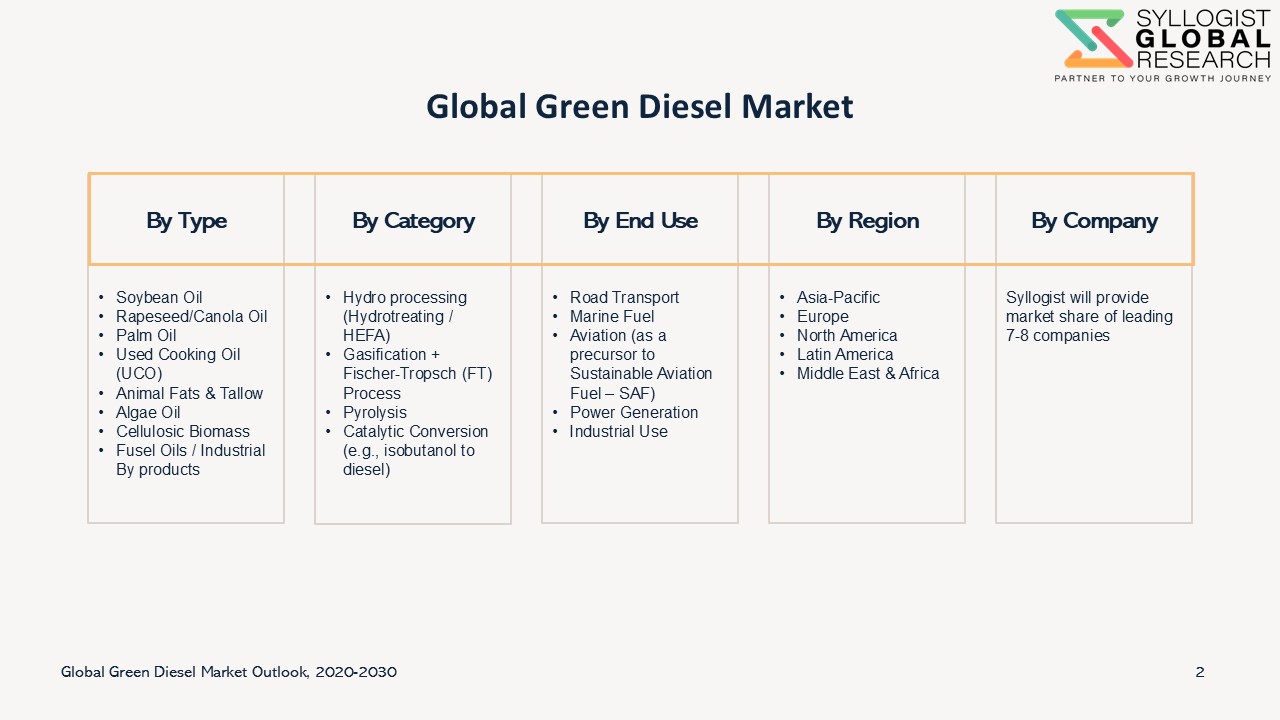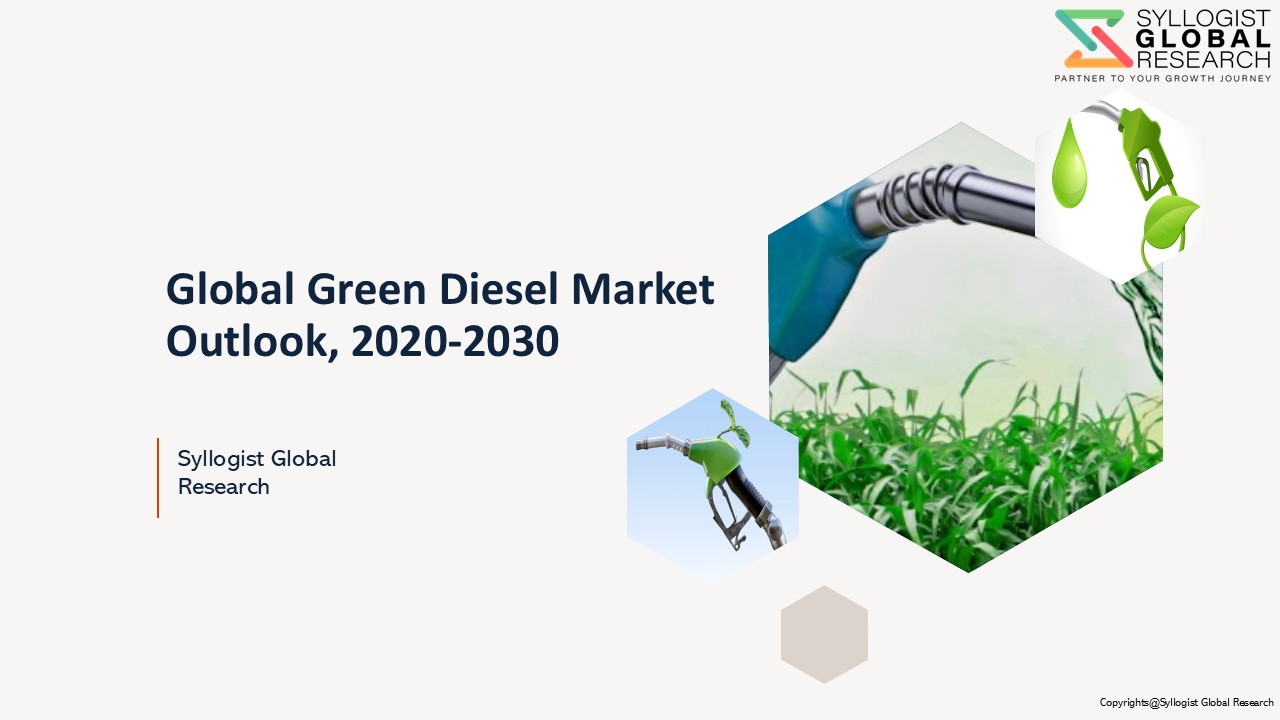- Overvew
- Table of Content
- Segmentation
- Request Sample
Market Definition
Green diesel, also referred to as renewable diesel, hydrotreated vegetable oil (HVO), hydrogenation-derived renewable diesel (HDRD), or hydroprocessed esters and fatty acids (HEFA), is classified as a second-generation biodiesel. Conventional biodiesel, chemically known as fatty acid methyl ester (FAME), is produced through transesterification, whereas green diesel differs significantly in its production pathway.
Green diesel is manufactured through processes more closely aligned with conventional petroleum refining, such as fractional distillation and catalytic hydroprocessing. This involves reactions like hydrotreating, decarboxylation, and decarbonylation applied to triacylglycerols and other renewable feedstocks. While alternative production technologies are being researched, hydrotreating remains the most widely adopted and commercially viable method today.
A key advantage of green/renewable diesel is its ability to meet existing fossil diesel specifications, specifically ASTM D975 in the United States and EN 590 in Europe, enabling seamless integration into current fuel infrastructure and vehicle engines without the need for blending or modifications.
Market Insights
Driven by regulatory mandates and sustainability targets, North America, particularly the United States and Canada, has emerged as a key demand hub for green/renewable diesel.
In the United States, and particularly in California, demand for green/renewable diesel has been driven by the Low Carbon Fuel Standard (LCFS) program. With strong adoption by automakers, utilities, and oil companies, the market has shifted first from biodiesel to renewable diesel. Renewable diesel holds a significant advantage, generating about 13% more federal compliance credits per gallon (RINs) compared to biodiesel, and is currently recognized as the lowest-carbon fuel under California’s LCFS, even lower than electric vehicles.
California’s renewable diesel consumption grew from negligible volumes in 2011 to 340 million gallons annually by 2017, and is projected to reach at least 1.35 billion gallons annually by 2030, accounting for roughly 36% of the state’s diesel demand. This marks a sharp increase compared to Q2 2018, when renewable diesel represented just over 10% of California’s diesel supply. Beyond California, other LCFS-driven markets such as Oregon, Washington, and British Columbia are also expected to experience strong growth. Together, these regions could generate demand exceeding 5 billion gallons per year by 2030.
At the federal level, the Renewable Fuel Standard (RFS) has further accelerated adoption. Established under the Energy Policy Act of 2005 and later expanded by the Energy Independence and Security Act of 2007, the RFS mandates a minimum share of renewable fuels in U.S. transportation fuel.
Canada is also seeing momentum in renewable diesel adoption. Companies such as Cielo Waste Solutions have announced plans to develop new refineries, including one in Lethbridge, Alberta. In 2018, the City of Vancouver signed a fuel contract with Suncor, requiring all municipal diesel vehicles to transition to 100% renewable diesel. This initiative alone is expected to reduce emissions by at least 50% compared to 2007 levels.
The green/renewable diesel market is primarily demand-driven and is attracting significant R&D investments from industry players. Current research efforts are concentrated on optimizing production technologies and exploring diverse feedstocks with the goal of improving efficiency and lowering production costs for renewable diesel.
A notable innovation in the green/renewable diesel sector comes from Gevo, which has introduced a novel production process capable of converting isobutanol or fusel oils into renewable diesel. Fusel oil, a byproduct generated during bioethanol or alcohol fermentation processes, typically holds limited market value. By leveraging this low-cost feedstock, Gevo’s approach can significantly reduce the production cost of renewable diesel, making it more competitive with conventional fuels. This advancement has the potential to accelerate adoption and drive wider market penetration of green/renewable diesel.
Market Dynamics: Drivers
Stricter Environmental Regulations
A major force behind the growth of the green/renewable diesel market is the increasing number of environmental regulations aimed at reducing carbon emissions from transportation. Policies like the Low Carbon Fuel Standard (LCFS) in California and the Renewable Fuel Standard (RFS) at the federal level in the U.S. create a strong market for renewable diesel by incentivizing low-carbon fuels. Similarly, Europe’s Renewable Energy Directive (RED II) mandates the use of renewable fuels in road transport. These policies not only ensure a consistent demand but also make renewable diesel financially competitive against traditional fossil fuels, pushing its adoption in major developed economies.
The “Drop-in” Fuel Advantage
Renewable diesel is a “drop-in fuel,” meaning it is chemically identical to conventional diesel. This allows it to be used in existing engines and fuel infrastructure without any modifications. Unlike biodiesel, which has blending limitations (typically 5-20%), renewable diesel can be used in its pure form (RD100). This seamless compatibility makes it a highly attractive and practical solution for fleet operators, logistics companies, and municipalities. It eliminates the need for costly upgrades, allowing for a swift and scalable transition to a lower-carbon fuel.
Corporate Sustainability & ESG Goals
Companies are increasingly adopting renewable diesel to meet their own ambitious sustainability goals and comply with growing pressure from Environmental, Social, and Governance (ESG) frameworks. Industries with high emissions, such as aviation, shipping, and trucking, are actively seeking to decarbonize their operations. Global logistics companies are transitioning their fleets, and municipal governments are converting public service vehicles to renewable diesel. Beyond regulatory compliance, choosing renewable diesel helps companies enhance their brand image and demonstrate leadership in sustainability, making it a crucial tool for meeting long-term climate commitments.
Market Dynamics: Challenges
High Production Costs
Despite its environmental benefits, renewable diesel production is currently more expensive than producing conventional diesel. This is primarily due to two factors. First, the required technologies, such as hydroprocessing and hydrogenation, demand significant capital investment. Second, the cost of feedstocks like vegetable oils, animal fats, and used cooking oils is often high and volatile, especially when there is strong competition for these resources from the food and biodiesel industries. While government incentives like the Low Carbon Fuel Standard (LCFS) help offset these costs in some regions, renewable diesel struggles to be price-competitive in markets without such support, limiting its widespread adoption.
Feedstock Availability and Supply Chain Constraints
A critical bottleneck for the industry is the limited and often unstable supply of suitable feedstocks. Renewable diesel production relies on a narrow range of materials, including vegetable oils and waste fats. The high demand for these feedstocks from various industries leads to fierce competition and price fluctuations. Furthermore, over-reliance on vegetable oils raises concerns about land use, deforestation, and food security. While waste-based feedstocks like used cooking oil are highly sought after, their collection and logistics infrastructure are underdeveloped in many parts of the world. Without the development of new, scalable feedstocks like algae or agricultural residues, the industry faces a significant challenge in meeting its long-term growth potential.
Market Segmentation
- Based on Feedstock, the Global Green Diesel market is segmented into
- Vegetable Oils
- Soybean Oil
- Rapeseed/Canola Oil
- Palm Oil
- Waste Oils & Fats
- Used Cooking Oil (UCO)
- Animal Fats & Tallow
- Others / Emerging Feedstocks
- Algae Oil
- Cellulosic Biomass
- Fusel Oils / Industrial By-products
- Vegetable Oils
- Based on Technology, the Global Green Diesel market is segmented into
- Hydro processing (Hydrotreating / HEFA)
- Gasification + Fischer-Tropsch (FT) Process
- Pyrolysis
- Catalytic Conversion (e.g., isobutanol to diesel)
- Based on End Users, the Global Green Diesel market is segmented into
- Transportation Fuel
- Road Transport (Commercial fleets, passenger vehicles, buses)
- Marine Fuel
- Aviation (as a precursor to Sustainable Aviation Fuel – SAF)
- Power Generation
- Industrial Use
- Transportation Fuel
- Based on Geography, the Global Green Diesel market is segmented into
- Asia-Pacific
- North America
- Europe
- Latin America
- Middle East & Africa
- All market revenue has been given in US Dollar, while the market volumes are given in million tons.
Historical Year: 2020-2024
Base Year: 2025
Estimated: 2026
Forecast- 2027-2030
Key Questions this Study will Answer
- What are the key overall market statistics or market estimates (Market Overview, Market Size- By Value, Market Size-By Volume, Forecast Numbers, Market Segmentation, Market Shares) of Global Green Diesel Market?
- What is the region wise industry size, growth drivers and challenges key market trends?
- What are the key innovations, opportunities, current and future trends and regulations in the Global Green Diesel Market?
- Who are the key competitors, what are their key strength and weakness and how they perform in Global Green Diesel Market based on competitive benchmarking matrix?
- What are the key results derived from the market surveys conducted during Global Green Diesel Market study?
- Strategic Introduction
- Definition & Scope of Green Diesel
- Market Architecture & Taxonomy
- Research Framework & Methodology
- Data Mining, Secondary & Primary Research
- Market Sizing & Validation (Top-Down, Bottom-Up, Demand/Supply Analysis)
- Scenario Calibration (Feedstock Availability, Government Policies & Incentives, Adoption & Penetration Rate, Price & Economics, Supply Chain & Logistics Constraints, External Market Drivers)
- Executive Insights
- Strategic snapshot of the Green Diesel market landscape, highlighting sustainability drivers, investment priorities, and scale-up readiness
- Key findings and actionable insights to guide boardroom decision-making and long-term strategy
- Future Outlook & Opportunity Mapping (2025–2035)
- Scenario Planning (Base, Optimistic, Conservative)
- Sensitivity Analysis
- Identification of regional investment hotspots
- Green Diesel’s Positioning in the Low-Carbon Transition
- Value Chain & Ecosystem Analysis
- Feedstock Sourcing & Upstream Inputs
- Conversion Technologies & Midstream Processing
- Distribution & Logistics Infrastructure
- Market Adoption & Downstream End-Use
- Digitalization & Traceability in the Value Chain
- Stakeholder Mapping
- Policy & Certification Ecosystem
- Sustainability & Circular Economy Integration
- Global Market Outlook (2020–2035)
- Market size and forecast by value
- Type, Category and End-Use, Regional, and Company Segmentation
- Regional Deep-Dive Analysis (2020–2035)
- Asia-Pacific (China, India, Australia, South Korea)
- Europe (Germany, France, The Netherlands)
- North America (U.S., Canada)
- South America (Brazil, Argentina, Colombia)
- Middle East & Africa (UAE, South Africa)
- Each region includes:
- Market size & forecast
- Adoption by Type, Category, End Use
- Country-specific regulatory landscape
- Each region includes:
- Policy & Regulatory Landscape
- Introduction to Policy & Regulatory Frameworks
- Global & International Frameworks
- Regional & Country-Level Policies
- Policy Instruments & Incentives
- Certification & Sustainability Standards
- Trade & Border Measures
- Comparative Policy Analysis
- Future Policy Trends & Outlook (2025–2035)
- Technology & Production Pathways
- Introduction to Green Diesel Technologies
- Established Production Pathways
- Emerging & Next-Generation Pathways
- Feedstock Considerations & Availability
- Technology Readiness & Certification
- Cost, Performance & Scalability Benchmarking
- Technology Providers & Licensors
- Digitalization & Innovation in Production
- Future Technology Outlook (2025–2035)
- Market Dynamics
- Growth drivers, restraints, challenges, opportunities
- Future Outlook & Structural Shifts (2025–2035)
- White Space & Growth Frontiers
- Unexplored Regional Markets
- Hybrid & Integrated Models
- Next-Generation Technology Frontiers
- Demand-Side Growth Opportunities
- Policy & Financing White Spaces
- Sustainability & ESG Frontiers
- Workforce, Skills & Digitalization Frontiers
- Long-Term Growth Outlook (2030–2040)
- Pricing & Economics
- Production Cost Benchmarking Across Technologies
- HEFA/HVO pathways
- Co-processing in petroleum refineries
- BtL (Biomass-to-Liquids) and AtJ pathways
- PtL/e-diesel production models
- CapEx & OpEx Breakdown
- Regional Pricing Models
- Break-even Analysis
- Comparative Price Trends (2020–2035)
- Role of Carbon Pricing, Subsidies & Credits
- Market Mechanisms & Pricing Models
- Economic Competitiveness & Investment Outlook
- Production Cost Benchmarking Across Technologies
- Project Case Studies (Global Best Practices)
- Successful Implementations Across Regions
- Lessons Learned from Failures & Challenges
- Benchmarking of Project Economics
- Technology Adoption Roadmaps
- Partnerships & Collaborations
- Sustainability & ESG Dimensions
- Future Outlook from Case Studies
- ESG & Sustainability Dimensions
- Environmental Dimensions
- Social Dimensions
- Governance Dimensions
- Sustainable Financing & Investment Alignment
- Risks & Challenges in ESG Adoption
- Future Outlook
- Investment & Financing Models
- CapEx & OpEx Patterns
- Sources of Capital & Financing Structures
- Incentives & Policy-Linked Financing
- Risk–Return Models
- ESG & Sustainable Finance Dimensions
- Strategic Investor Participation
- Regional Investment Trends
- Future Outlook (2025–2035)
- Talent, Skills & Workforce Transformation
- Workforce Requirements Across the Value Chain
- Skills Gaps & Reskilling Needs
- Emerging Digital & Technical Skills
- Policy & Institutional Support for Workforce Development
- Social & Regional Workforce Implications
- Future Outlook (2025–2035)
- Risk Assessment Framework
- Political/Regulatory Risk
- Operational Risk
- Environmental & Social Risks
- Financial Risk
- Market & Competitive Risks
- Technology Risks
- Risk Mitigation Strategies
- Future Outlook
- Strategic Roadmap & Recommendations
- Short-Term Roadmap (2025–2027)
- Mid-Term Roadmap (2028–2030)
- Long-Term Roadmap (2031–2035)
- Tailored Recommendations by Stakeholder
- For Producers & Refiners
- For Policymakers & Regulators
- For Investors & Financial Institutions
- For Technology Providers
- For End-Users (Fleets, Airlines, Shipping)
- Key Success Factors
- Future Outlook & Strategic Priorities


